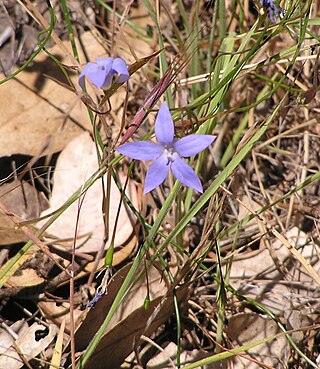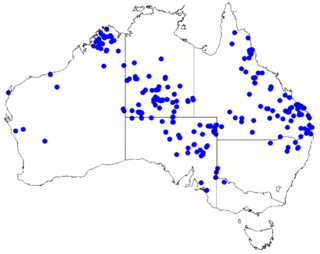
Wahlenbergia gloriosa, commonly known as royal bluebell is a perennial herb in the bluebell family Campanulaceae. It has egg-shaped leaves near the base of its stem, linear leaves higher up and usually a single purple flower with a tube-shaped base. The flower is the floral emblem of the Australian Capital Territory.

Wahlenbergia is a genus of around 260 species of flowering plants in the family Campanulaceae. Plants in this genus are perennial or annual herbs with simple leaves and blue to purple bell-shaped flowers, usually with five petals lobes. Species of Wahlenbergia are found on all continents except North America, and on some isolated islands, but the greatest diversity occurs in the Southern Hemisphere.

Wahlenbergia stricta, the Australian bluebell, tall bluebell or austral bluebell, is an Australian wildflower from the Campanulaceae family. It is considered the most commonly encountered of the Wahlenbergias. It is found in all Australian states but not the Northern Territory. It is often seen growing by the side of the road, enjoying the extra runoff.

The putative hybrid cultivar Ulmus × hollandica 'Serpentina' is an elm of unknown provenance and doubtful status. Henry identified it as intermediate between U. glabra and U. minor, a view accepted by Bean and by Melville, who believed that the specimens at Kew bearing the name 'Serpentina' were U. glabra "introgressed by U. carpinifolia" [: U. minor] and were similar to but "distinct from 'Camperdownii'".

Wahlenbergia gracilis, common name Australian bluebell, is an Asian wildflower from the family Campanulaceae. It also grows on western Pacific Ocean islands.

Hesperocodon hederaceus, synonym Wahlenbergia hederacea, also known as the ivy-leaved bellflower, is a species of flowering plant that is found throughout Europe. It is the only species in the genus Hesperocodon. The delicate, patch-forming, hairless perennial herb has thin, creeping stems about 20 cm in length. Its pale green leaves are long-stalked and have an ivy-shaped, rounded structure. These leaves can be described as having a cordate shape and are approximately 5–12 mm long and wide. The plant has erect, solitary, pale blue flowers in summer and autumn, with bell-shaped corolla with 5 short lobes. The flowers are 6–10 mm long x 5–8 mm wide and sit on fine stalks 1–4 cm long. It is suggested that the long pedicels are an adaptation to assist in seed dispersal.

The elm cultivar Ulmus 'Glabra' was distributed by the Späth nursery, Berlin, in the 1890s and early 1900s as U. glabraMill.. Not to be confused with the species U. glabraHuds..

Wahlenbergia capillaris, commonly known as tufted bluebell, is a plant in the family Campanulaceae and is native to Australia and New Guinea. It is an erect perennial herb with a few to many stems and grows to a height of 50 cm (20 in). The leaves are mostly linear with a few scattered teeth on the sides and the flowers are blue, bell-shaped with five lobes and arranged in cymes. This bluebell is widespread and common, occurring in all Australian mainland states and territories.
Wahlenbergia multicaulis is a small herbaceous plant in the family Campanulaceae native to Australia.
Wahlenbergia preissii is a small herbaceous plant in the family Campanulaceae native to Western Australia.

Wahlenbergia queenslandica is a small herbaceous plant in the family Campanulaceae native to Western Australia, to New South Wales, Queensland, the Northern Territory, and South Australia.

Wahlenbergia fluminalis, commonly known as the river bluebell, is a small herbaceous plant in the family Campanulaceae native to eastern Australia.
Wahlenbergia densifolia, commonly known as the fairy bluebell, is a small herbaceous plant in the family Campanulaceae native to eastern Australia.
Wahlenbergia graniticola, commonly known as the granite bluebell, is a herbaceous plant in the family Campanulaceae native to eastern Australia.
Wahlenbergia planiflora, commonly known as flat bluebell, is a small herbaceous plant in the family Campanulaceae native to eastern Australia.

Wahlenbergia scopulicola is a herbaceous plant in the family Campanulaceae native to eastern Australia.

Wahlenbergia capensis, commonly known as the Cape bluebell, is a plant in the family Campanulaceae and is native to the Cape Province but has been introduced to Australia. It is an annual herb with up to four greenish blue, bell-shaped flowers with spreading petal lobes.

Roger Charles Carolin is a botanist, pteridologist and formerly an associate professor at Sydney University. He was appointed as a lecturer in botany at the University of Sydney in 1955 earned a Ph.D from Sydney University in 1962 with a thesis on the floral morphology of the campanales, and retired as an associate professor in 1989.











